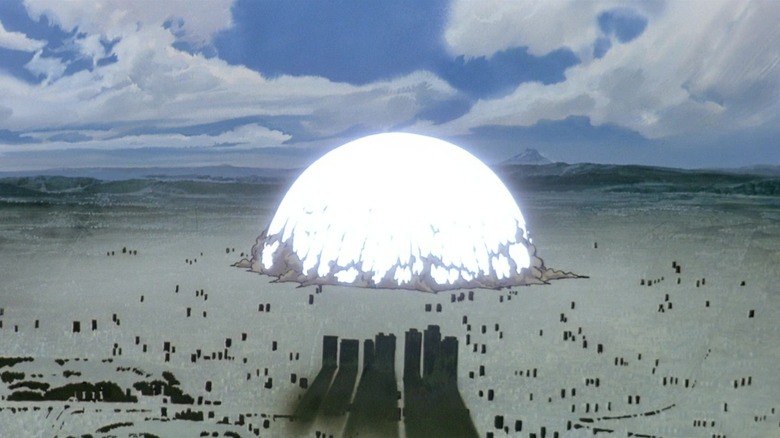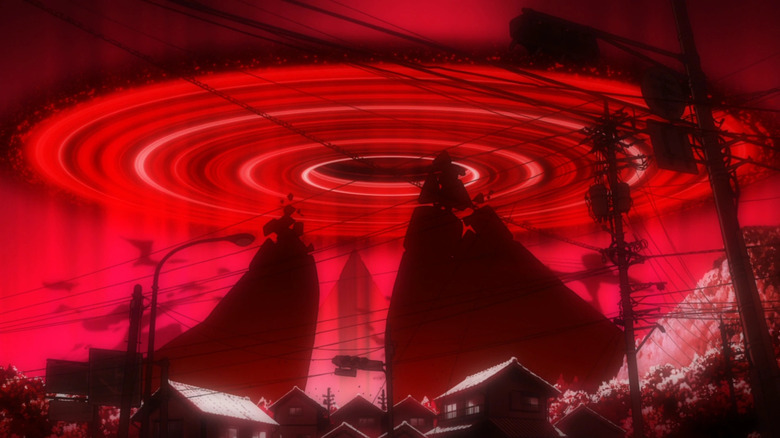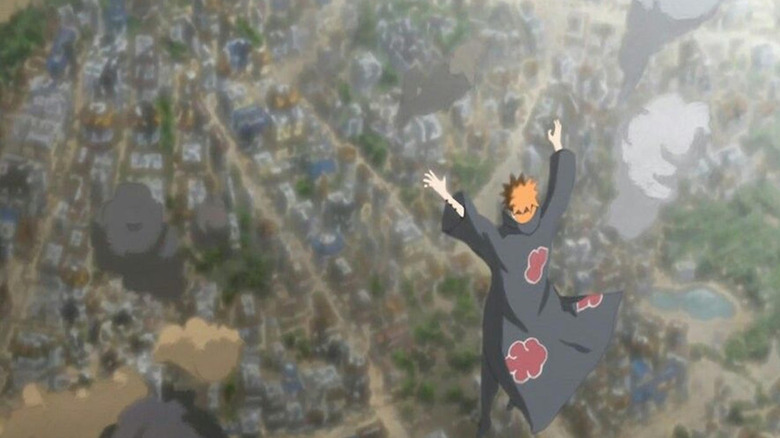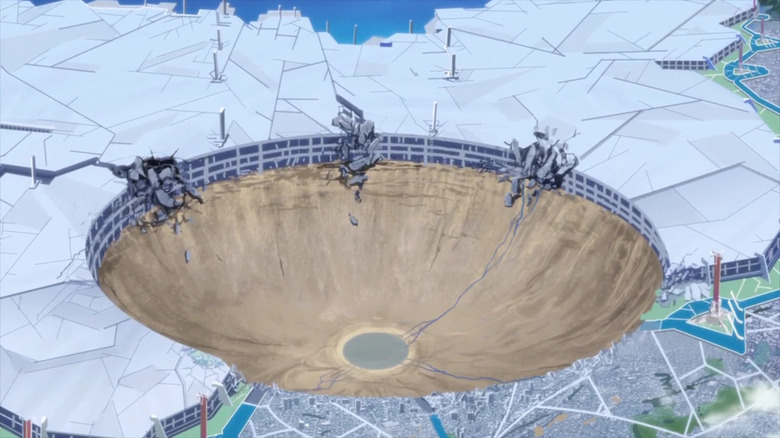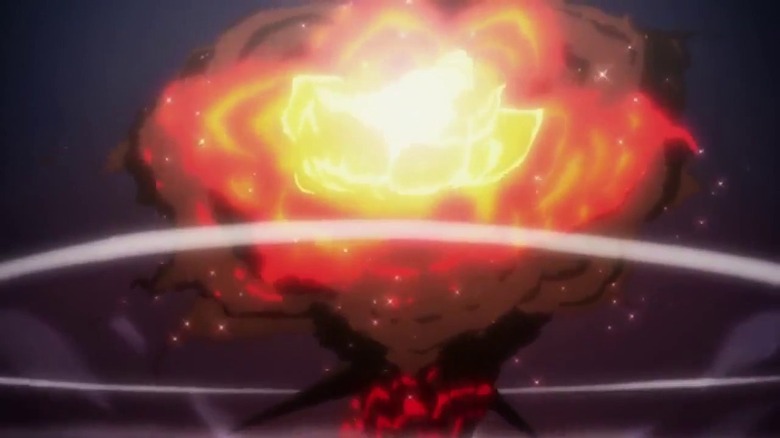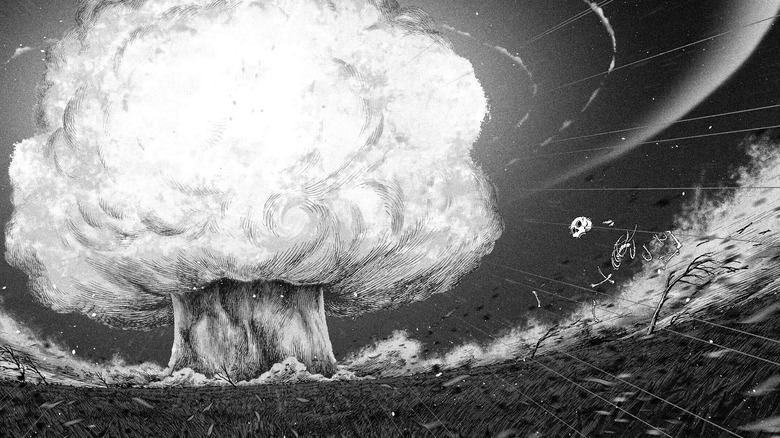How Anime Explores Japan's National Trauma Over The Atomic Bomb
This post contains spoilers for "Oppenheimer."
"Oppenheimer" is now out in theaters. Directed by Christopher Nolan with his go-to man Cillian Murphy in the leading role, the film chronicles J. Robert Oppenheimer's involvement in the Manhattan Project from its build-up to its aftermath.
The film doesn't show the bombings of Hiroshima and Nagasaki, but it does condemn them. All onscreen U.S. military and political higher-ups are gung-ho that the bombings be carried out and downright flippant about the loss of life in Japan. When Oppenheimer despairs that he has blood on his hands, President Harry Truman (Gary Oldman) eyes him with disdain and calls him a "crybaby."
Whether the bombings were justified or not is a debate that will rage far into the future. What's undeniable is that the loss of life (between 110,000 to over 220,000) left a scar on Japan. They hold the unique distinction of being the only country to be hit with the full might of atomic warfare. Japanese pop culture in the 20th and 21st centuries has been shaped by this traumatic cultural memory, akin to how 21st century U.S. superhero movies are largely a cultural response to 9/11.
In the original 1954 "Godzilla," the titular kaiju was depicted as nature's revenge against man's atomic testing. Dr. Serizawa (Akihiko Hirata), who creates an oxygen-destroying device to stop Godzilla, is practically a Japanese Oppenheimer.
Osamu Tezuka's "Astro Boy," the harbinger of modern manga and anime, is about an atomic-powered robot. Katsuhiro Otomo's cyberpunk manga/film "Akira" features an explosion engulfing the futuristic Neo-Tokyo. And in many modern, serialized anime series, city-leveling bombs are a frequent plot device or a representation of ultimate evil. Once you notice a few examples, it becomes impossible not to see the trend.
Nuclear impact
"Neon Genesis Evangelion" takes place in a world where the world was knocked off axis by the "Second Impact" — a primordial "Angel" dubbed Adam awakened in Antarctica. More of Adam's kind come alive one by one, intending to finish the job with a Third Impact. The organization NERV creates enormous Evangelion units to fight the Angels.
NERV is like a mecha Manhattan Project, creating weapons of mass destruction in an escalating arms race. The Angels, which range from run-of-the-mill kaiju to metaphysical monsters, frequently level Tokyo 2.0 with explosive attacks.
A late-game twist is that the Evangelions are not robots or mechas. They're clones of Adam outfitted with armor to keep them under human control. By creating and deploying them, NERV wields a power it cannot fully master. Misato Katsuragi aptly describes this and the atomic bomb: "Attempting to harness the engine of our own destruction — only humans are so foolish."
The backstory of the Second Impact also resonates with real Japanese culture; the characters of "Evangelion" live in a world forever changed by a not-so-natural cataclysm. When the Third Impact eventually transpires in the feature-length finale "The End of Evangelion," part of the horror is seeing nuclear-level destruction on a planetary scale.
Hideaki Anno, creator of "Evangelion," is a fan of Tokusatsu, or effects-heavy Japanese media. "Evangelion" fits that genre as much as mecha anime. Tokusatsu (such as "Super Sentai," the source material of "Power Rangers") is often about fighting giant, city-leveling monsters — another cultural consequence of the bomb. Anno even directed "Shin Godzilla" in 2016, reviving the original Japanese nuke allegory.
Shinra Tensei
Masashi Kishimoto's "Naruto" is one of the most popular anime/manga in circulation — even people who don't know the meaning of "otaku" have heard of it. The series takes place in a world loosely resembling feudal Japan, with nations protected by ninja villages. Our hero is a young boy from Konoha/the Leaf Village, Naruto Uzumaki, who wants to become his village's leader. The problem is, no one trusts him because his soul is bound to a demon called Kurama, the Nine-Tailed Fox.
What does a story like "Naruto," about magic-using ninjas in a technologically underdeveloped world, have to do with nukes? It goes back to the villains. In "Part II" of the series (known as "Naruto: Shippuden" in the anime), the villains are the Akatsuki — 10 ninjas out to capture the tailed beasts, including Kurama.
The Akatsuki's leader, Pain, was once a war orphan named Nagato. His plan is to use the tailed beasts to create and then unleash a weapon more powerful than the world has ever seen. The cataclysmic destruction, he believes, will be enough to dissuade any nation from waging war against another.
Pain's plan is, in essence, that of the 20th-century U.S.: browbeat a warring nation into surrender with overwhelming force. Then, keep that weapon in reserve to create fear of mutually assured destruction. If you think the world is inherently violent, then a cold war is the closest substitute to peace. Naruto, and the story, ultimately reject that notion.
To support his conclusion, Kishimoto doesn't leave the Akatsuki's desired destruction to his audience's imagination. Pain's powers include gravity manipulation, dubbed Shinra Tensei ("Almighty Push"). In chapter 429/episode 162, he uses that power to hover above Konoha and generate a shockwave, turning the village into a lifeless crater.
The Sword of Damocles
"Code Geass: Lelouch of the Rebellion" takes place in an alternate history, but one without a single divergence point. In the "CG" timeline, Britain put down the American Revolution. However, a few decades later, Napoleon successfully took the British Isles. Thus, the Royals fled to the American colonies, which became the new homeland of the "Holy Britannian Empire." By the 2010s, the Britannians have invented mechs called Knightmares (this is an anime) and conquered a third of the world. Lelouch, a Britannian prince exiled to Japan, leads a rebellion as the masked "Zero."
The Britannians are practically a parody of Western Imperialism — in season 2, they develop a nuke analogue, the Field Limitary Effective Implosion Armament (F.L.E.I.J.A.). Even in a timeline unrecognizable from our own, humanity will always develop the capacity to destroy itself. Likewise, the site of the initial FLEIJA demonstration is Tokyo, which is not just burnt to a radioactive crisp but outright vaporized.
Lelouch, as part of a complex plan to bring about world peace (by making himself a villain to be defeated), seizes control of an orbital, FLEIJA-launching base called Damocles. With that power, he declares himself Emperor of the World. As in reality, powers with weapons of mass destruction can bully other nations into compliance. Part of the happy ending after Lelouch's death is Damocles drifting into the sun along with the remaining FLEIJA warheads. Unlike the real world, the atomic genie is put back into its bottle, where it should've remained all along.
The evil in men's heart
Yoshihiro Togashi's "Hunter x Hunter" is a shonen (boys) series in the vein of "Naruto," one about licensed adventurers called "Hunters." The fifth arc is about them fighting mutant "Chimera Ants," who take on the appearance and abilities of whatever they consume — in this case, human and animals.
The arc builds to a fight between Hunter Chairman Netero and Ant King Meruem. In the meantime, Meruem goes through some dramatic personal growth, so when he finally meets Netero, he wants to negotiate. Netero refuses to hear him out — to destroy your enemies, you have to (for lack of a better word) dehumanize them.
While Netero loses, he had anticipated his defeat and planted a failsafe inside his chest. Netero describes to Meruem and us the "bottomless malice within the human heart" — of course, that malice is a nuclear bomb. Netero plunges his hand into his chest and trips the "Poor Man's Rose," which explodes into the shape of a fiery flower (evoking the description "mushroom cloud").
After the explosion, the narrator hits pause on the story to take the audience through a montage showing the pure horror experienced by nations targeted with these bombs. A theme of the Chimera Ant arc is the dissonance of humanity's capacity for both good and evil. For Togashi, nuclear weapons are the ultimate manifestation of the latter — the symbolism of the bomb being in Netero's literal heart couldn't be more obvious.
The flower symbolism turns out to have double meaning too; like a plant spreading its roots and seeds, the bomb lingers on via radiation. Meruem barely survives the explosion, but he dies soon after from radiation sickness. What makes nukes more evil than conventional bombs is that they don't just raze people and land, they poison them.
Weapons of the future
Even an anime about Vikings can have anti-nuclear imagery and messaging. "Vinland Saga" is a manga created by Makoto Yukimura. The anime, with its just-finished second season, has only adapted up to chapter 101 — fans might be surprised by what the source material has in store for them.
"Vinland" was the name that the Viking-age explorer Leif Erikson gave to the western continent we call North America. The main character, Thorfinn, heard stories about Vinland as a child. Eventually, his goal becomes settling there to create a country free from war or slavery. In the manga's ongoing fourth arc, he and his compatriots make it to Vinland and establish a colony.
Like the later European settlers, they have to contend with distrust from the Natives (specifically Mi'kmaq/L'nu tribe), some of whom don't like strangers on their land. In Chapter 189, the shaman Miskwekepu'j plunges into a vision to decipher the intentions and futures of the Norsemen. He sees his homeland's future; future colonizers, the U.S. Civil War, and the subjugation of his own people. Eventually, industrialization and war combine into, what else, the atomic bomb. Such destructive power would've been incomprehensibly terrifying in the 11th century and it turns Miskwekepu'j against the settlers permanently.
However, "Vinland Saga" also demonstrates another part of Japan's national reaction to the bomb; the aversion to violence altogether (Article 9 of the current Japanese constitution prohibits waging war). The main theme of "Vinland Saga" is pacifism — "a true warrior doesn't need a sword" — and if it's possible to be a peaceful person in a violent world. Thorfinn becomes a vengeful warrior but war causes him only suffering. After he understands the consequences of his actions, he repents them. Only a man — or a nation — who has tasted violence can hate it.
